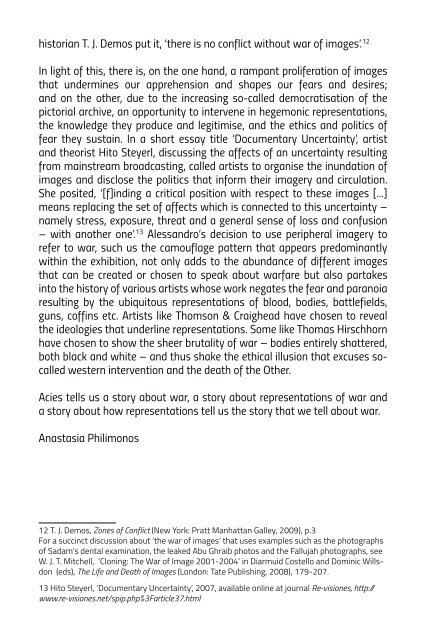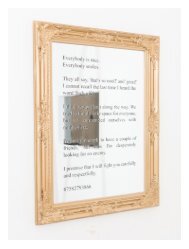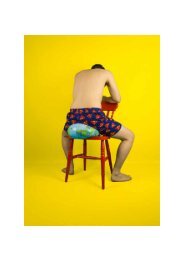Acies
This publication accompanies the exhibition “Acies” by Alessandro Di Massimo. It includes texts by Anastasia Philimonos and Alessandro Di Massimo and images of the show. A5, 18 pages, b/w, hand made cover made with sandpaper. First published by the artist for the exhibition “Acies”, 17 – 24 November 2017, The Number Shop, Edinburgh. All rights reserved.
This publication accompanies the exhibition “Acies” by Alessandro Di Massimo. It includes texts by Anastasia Philimonos and Alessandro Di Massimo and images of the show.
A5, 18 pages, b/w, hand made cover made with sandpaper.
First published by the artist for the exhibition “Acies”, 17 – 24 November 2017, The Number Shop, Edinburgh.
All rights reserved.
You also want an ePaper? Increase the reach of your titles
YUMPU automatically turns print PDFs into web optimized ePapers that Google loves.
historian T. J. Demos put it, ‘there is no conflict without war of images’. 12<br />
In light of this, there is, on the one hand, a rampant proliferation of images<br />
that undermines our apprehension and shapes our fears and desires;<br />
and on the other, due to the increasing so-called democratisation of the<br />
pictorial archive, an opportunity to intervene in hegemonic representations,<br />
the knowledge they produce and legitimise, and the ethics and politics of<br />
fear they sustain. In a short essay title ‘Documentary Uncertainty’, artist<br />
and theorist Hito Steyerl, discussing the affects of an uncertainty resulting<br />
from mainstream broadcasting, called artists to organise the inundation of<br />
images and disclose the politics that inform their imagery and circulation.<br />
She posited, ‘[f]inding a critical position with respect to these images [...]<br />
means replacing the set of affects which is connected to this uncertainty –<br />
namely stress, exposure, threat and a general sense of loss and confusion<br />
– with another one’. 13 Alessandro’s decision to use peripheral imagery to<br />
refer to war, such us the camouflage pattern that appears predominantly<br />
within the exhibition, not only adds to the abundance of different images<br />
that can be created or chosen to speak about warfare but also partakes<br />
into the history of various artists whose work negates the fear and paranoia<br />
resulting by the ubiquitous representations of blood, bodies, battlefields,<br />
guns, coffins etc. Artists like Thomson & Craighead have chosen to reveal<br />
the ideologies that underline representations. Some like Thomas Hirschhorn<br />
have chosen to show the sheer brutality of war – bodies entirely shattered,<br />
both black and white – and thus shake the ethical illusion that excuses socalled<br />
western intervention and the death of the Other.<br />
<strong>Acies</strong> tells us a story about war, a story about representations of war and<br />
a story about how representations tell us the story that we tell about war.<br />
Anastasia Philimonos<br />
12 T. J. Demos, Zones of Conflict (New York: Pratt Manhattan Galley, 2009), p.3<br />
For a succinct discussion about ‘the war of images’ that uses examples such as the photographs<br />
of Sadam’s dental examination, the leaked Abu Ghraib photos and the Fallujah photographs, see<br />
W. J. T. Mitchell, ‘Cloning: The War of Image 2001-2004’ in Diarmuid Costello and Dominic Willsdon<br />
(eds), The Life and Death of Images (London: Tate Publishing, 2008), 179-207.<br />
13 Hito Steyerl, ‘Documentary Uncertainty’, 2007, available online at journal Re-visiones, http: /<br />
www.re-visiones.net/spip.php%3Farticle37.html







